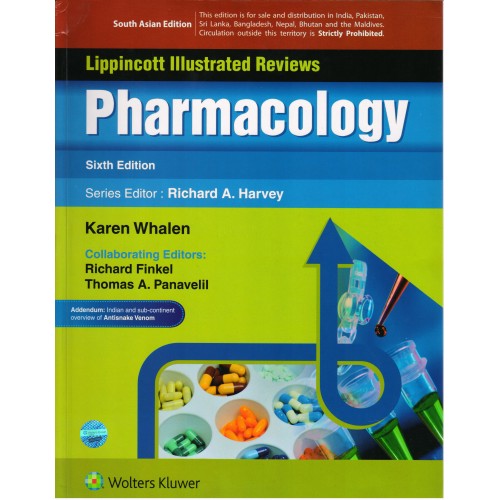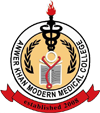Anwer Khan Modern Medical College
Library Management System

| Title: | Lippincott illustrated reviews: pharmacology |
| Author Name: | Karen Whalen |
| Author Sur Name: | WHALEN. Karen. |
| Other's Author Name: | Richard Finkel and Thomas A. Panavelil [Collaborating Authors] |
| Author information: |
|
| Edition/Published: | 6th ed. _New Delhi : Wolters Kluwer , 2015 |
| New to this edition: |
|
|
Physical Description: xii, 670, : ill., tables, col.,images,.; 27.5cm. |
| Notes | Includes Index. |
| Includes Index: | P. 647-670 |
| ISBN No's: | 978-93-5129-338-5 |
| Bar Code's: | |
| Shelf Location's: | 47 |
| Classification | |
| Subject: | Pharmacology--Examination Questions. |
| Dewey Class No: | 615.1076 |
| Letter Call No: | W55l |
| LC Classification: | RM301.14 .P47 2015 |
| Other's Book Information | |
| Book ID No: | 1550 |
| Total Books: | 1 |
| Date of collection's: | 08-Nov-2015 |
| Donation / Purchase: | Purchase |
| Language: | English |
| Department: | Pharmacology |
| Synopsis: |
|
| Review: |
|
| Description: |
|
| Key Features: |
|
| Summary: |
|
| Abstract: |
|
| Preface: |
|
| Content: |
Contributing Authors… v Reviewer… vii Illustration and Graphic Design…vii UNIT I: Principles of Drug Therapy Chapter 1: Pharmacokinetics…1 Chapter 2: Drug–Receptor Interactions and Pharmacodynamics…25 UNIT II: Drugs Affecting the Autonomic Nervous System Chapter 3: The Autonomic Nervous System…39 Chapter 4: Cholinergic Agonists…51 Chapter 5: Cholinergic Antagonists…65 Chapter 6: Adrenergic Agonists…77 Chapter 7: Adrenergic Antagonists…95 Unit III: Drugs Affecting the Central Nervous System Chapter 8: Drugs for Neurodegenerative Diseases…107 Chapter 9: Anxiolytic and Hypnotic Drugs…121 Chapter 10: Antidepressants…135 Chapter 11: Antipsychotic Drugs…147 Chapter 12: Drugs for Epilepsy…157 Chapter 13: Anesthetics…171 Chapter 14: Opioids…191 Chapter 15: Drugs of Abuse…205 Chapter 16: CNS Stimulants…215 Contents ix x Contents x UNIT IV: Drugs Affecting the Cardiovascular System Chapter 17: Antihypertensives…225 Chapter 18: Diuretics…241 Chapter 19: Heart Failure…255 Chapter 20: Antiarrhythmics…269 Chapter 21: Antianginal Drugs…281 Chapter 22: Anticoagulants and Antiplatelet Agents…291 Chapter 23: Drugs for Hyperlipidemia…311 UNIT V: Drugs Affecting the Endocrine System Chapter 24: Pituitary and Thyroid…325 Chapter 25: Drugs for Diabetes…335 Chapter 26: Estrogens and Androgens…351 Chapter 27: Adrenal Hormones…365 Chapter 28: Drugs for Obesity…375 UNIT VI: Drugs for Other Disorders Chapter 29: Drugs for Disorders of the Respiratory System…381 Chapter 30: Antihistamines…393 Chapter 31: Gastrointestinal and Antiemetic Drugs…401 Chapter 32: Drugs for Urologic Disorders…415 Chapter 33: Drugs for Anemia…423 Chapter 34: Drugs for Dermatologic Disorders…431 Chapter 35: Drugs for Bone Disorders…441 Chapter 36: Anti-inflammatory, Antipyretic, and Analgesic Agents…447 Contents xi UNIT VII: Chemotherapeutic Drugs Chapter 37: Principles of Antimicrobial Therapy…471 Chapter 38: Cell Wall Inhibitors…483 Chapter 39: Protein Synthesis Inhibitors…499 Chapter 40: Quinolones, Folic Acid Antagonists, and Urinary Tract Antiseptics…513 Chapter 41: Antimycobacterial Drugs…525 Chapter 42: Antifungal Drugs…535 Chapter 43: Antiprotozoal Drugs…547 Chapter 44: Anthelmintic Drugs…561 Chapter 45: Antiviral Drugs…567 Chapter 46: Anticancer Drugs…587 Chapter 47: Immunosuppressants…619 UNIT VIII: Toxicology Chapter 48: Clinical Toxicology…631 Index…641 Figure Sources…663 |
